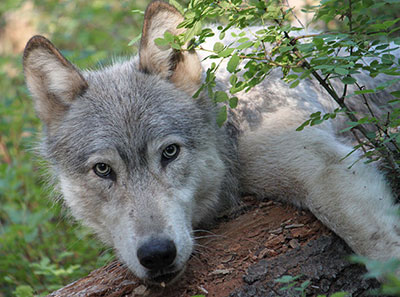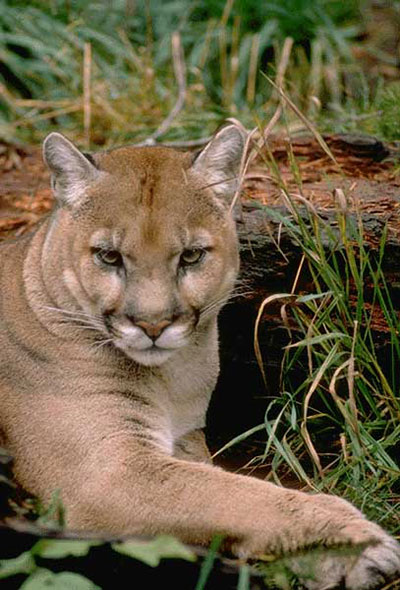Expert Q&A: Tierra Curry
By Amy Nelson
 Tierra Curry is a Senior Scientist with the Center for Biological Diversity, a U.S.-based nonprofit conservation organization dedicated to securing a future for plants and animals hovering on the brink of extinction. Tierra focuses on the listing and recovery of endangered species. Applying science, law, and creative media, she works nationally with individuals and groups in support of the conservation of species and the Endangered Species Act. In 2012, Tierra co-authored “On Time, On Target” a report documenting the success of the Endangered Species Act based on species rates of recovery. That same year, Tierra helped the Center for Biological Diversity win positive Endangered Species Act decisions for 104 animals and plants, and final protection for 33 species, including a San Francisco manzanita once believed to have vanished forever from the wild. Prior to joining the Center in 2007, Tierra worked as an amphibian field biologist, conservation corps crew leader, and community organizer. She holds a bachelor’s in English from Berea College in Kentucky and a master’s in biology from Portland State University.
Tierra Curry is a Senior Scientist with the Center for Biological Diversity, a U.S.-based nonprofit conservation organization dedicated to securing a future for plants and animals hovering on the brink of extinction. Tierra focuses on the listing and recovery of endangered species. Applying science, law, and creative media, she works nationally with individuals and groups in support of the conservation of species and the Endangered Species Act. In 2012, Tierra co-authored “On Time, On Target” a report documenting the success of the Endangered Species Act based on species rates of recovery. That same year, Tierra helped the Center for Biological Diversity win positive Endangered Species Act decisions for 104 animals and plants, and final protection for 33 species, including a San Francisco manzanita once believed to have vanished forever from the wild. Prior to joining the Center in 2007, Tierra worked as an amphibian field biologist, conservation corps crew leader, and community organizer. She holds a bachelor’s in English from Berea College in Kentucky and a master’s in biology from Portland State University.
Can you tell us about one or two new species that have been added to the ESA list recently?
The past two years have been very exciting in terms of new species gaining Endangered Species Act protection because under a settlement agreement with the Center for Biological Diversity and other conservation groups, the U.S. Fish and Wildlife Service has agreed to address the entire backlogged waiting list of “candidate” species by 2018. Candidates are species that warrant protection but that the Service hasn’t been able to prioritize finalizing protection for. Many of them have been sitting on a waiting list for more than 20 years. In the last two years, 107 species that the Center has advocated for over the years gained final ESA protection, and another 28 have been proposed for protection.
How many species are on this waiting list?
As of 2010 there were more than 250. Every fall, the Fish and Wildlife Service puts out the Candidate Notice of Review , where they take stock of all of the species on the waiting list and the progress they’ve made in getting them proposed for protection. In 2013 the number of species on the waiting list dropped to 146 as the result of our settlement agreement, marking the first time in two decades that the backlog is less than 150 species.
How do species get on the waiting list?
There are two ways species can get on the waiting list. The Fish and Wildlife Service can add a species straight to the waiting list if they realize it is in hot water. Citizens can also petition for Endangered Species Act protection for a species. [When that happens] the Fish and Wildlife Service is required to make what is called a “12-month finding.” At the end of the 12 month period, they either say “No, we’re not going to list it,” “Yes, we’re going to propose it for listing,” or “It is warranted but precluded.” Warranted but precluded puts it on the waiting list.
Some of the species that gained final protection last year are a songbird called the Streaked Horned Lark and a butterfly called Taylor’s Checkerspot that live in prairie habitats in Washington and Oregon. Streaked horned lark photo by David Maloney, USFWS.
Two freshwater mussels from the southeastern United States, the Fluted Kidneyshell and Slabside Pearlymussel, from Tennessee, Alabama, Kentucky, Mississippi and Virginia [now have protection.] Freshwater mussels are among the most imperiled animals in the world, with more than 70 percent of them being in danger of extinction. They are very sensitive to water pollution and also improve water quality by constantly filtering water. Protecting habitat for them will also help protect water quality for people.
38 species from Maui, including 35 plants and three tree snails, also recently gained final protection.
99% of the plants and animals under Endangered Species Act protection have been protected from extinction. Can you tell us about the 1% that have gone extinct and the lessons that can be gleaned from those extinctions?
Ten species have been delisted due to extinction. Of these, eight were placed on the endangered species list after they were already extinct. Two became extinct after they were protected, the Dusky Seaside Sparrow and the Mariana Mallard. The Dusky Seaside Sparrow was a songbird that lived in marshes along Florida’s Atlantic Coast. It declined initially due to DDT which caused its eggshells to be too thin. Its habitat was then destroyed due to wetland draining for construction and mosquito control. The last bird died in 1987 and it was declared extinct in 1990. The Mariana Mallard was a small duck from the Mariana Islands, near Guam. It went extinct due to draining of wetlands for agriculture and construction and due to hunting. The last bird died in captivity in 1981. It was declared extinct in 2004.
One of the most important lessons to be learned from these tragic extinctions is that we have to protect the habitat that endangered species need to survive. Capturing the last individuals and trying to get them to breed in captivity is to no avail if their habitat is being erased. We humans are going to have to learn to exercise some constraint when it comes to development so that more and more natural habitat isn’t converted to habitat solely for the use of people.

What is the status of the USFW’s 2013 proposal to drop ESA protections for the gray wolf? Has that proposal now been withdrawn?
In summer 2013 the Service proposed to remove gray wolves from the Endangered Species list. That proposal has not been finalized and has generated much scientific controversy. In the places where wolf protections have been lifted and management has been turned over to the states, more than 2,600 wolves have been killed since 2011. Taking that many animals out of the population is certainly going to affect social structure and reproduction. It’s going to undo the hard work people have done for decades to try to restore wolves.
This is an example of political interference with the Endangered Species Act where powerful groups successfully pressure the administration to lessen protections for species even though the scientific information available supports protection of the species. Wolves occupy five percent of their historic range. They are not recovered.
Another recent example of the administration bowing to industry pressure and removing protection for a species is the Dunes Sagebrush Lizard which lives in New Mexico and Texas in sand-dune habitat that overlaps with oil and gas drilling. The best available scientific information clearly indicates that the species warrants protection, and it was proposed for listing as endangered in 2010.The oil and gas industry was outraged and pressured the administration to withdraw the proposed listing, which they did. They are relying on voluntary measures to protect the lizard and on documents which are not publicly available. This is an egregious example of the Obama administration caving to pressure from the fossil fuel industry, ignoring the best available science, and sacrificing an endangered species.
How often does this kind of thing happen? How vigilant must the Center for Biodiversity and other guardians of the Endangered Species Act be?
It happens all the time. Right now, the state of Texas is launching an initiative to oppose endangered species listings for the state because of the conflict with oil and gas development. The state, the counties, and the oil and gas industries are all teamed up and actively opposing the listing of species.
The state of Florida wants endangered species protection to be turned over to the state. The board that would make those decisions has a lot of developers on it. You’d be turning over Endangered Species Act protection to a board comprised of people whose inherent interest is in making a profit off of destroying habitat. We don’t think this has a strong legal basis, and we’re challenging it in court.
The report “On Time, On Target,” which you co-authored, is a compelling defense of the ESA. It concludes that “when judged in light of meeting recovery plan timelines for recovery [as opposed to the # or overall percentage of species that have been delisted] the ESA is remarkably successful.” What brought about that report? What threats was the ESA facing, and from whom?
Periodically opponents of the Endangered Species Act launch campaigns to dismantle it. In recent years these attacks have been spearheaded by the Tea Party. The Endangered Species Act actually enjoys broad public support and support from both democrats and republicans, so the proposals to gut it are packaged as proposals to improve it. The far-right proposals to improve it generally consist of cutting funding , prohibiting the Service from listing any new species, turning endangered species protection over to the states, and relying on voluntary measures to save species. Doc Hastings, a representative from Washington, has led the recent efforts to “fix” the act by claiming that it doesn’t work because species aren’t being delisted. We put together On Time, On Target to provide data on how species are moving towards recovery.

The report attempts to answer the question of how to determine if species are recovering “fast enough.” What is “fast enough?” What was your answer?
Opponents of the Endangered Species Act frequently criticize the law for not recovering species quickly. By the time species make it on to the endangered species list, they are generally in very hot water, and it takes time to stabilize their populations and address the causes of their decline. It’s not realistic to expect them to recover in short time frames. The Florida Panther, for example, isn’t expected to recover until 2085. Species with slow population growth that are facing big threats will take a lot of time to improve. Stabilizing a species that is plummeting towards extinction should be viewed as a success.
The report includes case studies of species that have recovered and species that are likely to be delisted. In looking at these examples, and perhaps at other success stories you have observed or been a part of, what are some common threads that lead to success?
We know that species with designated critical habitat protection and species that have actual recovery plans developed by scientists are more likely to recover than species that do not have designated protected habitat or species that do not have recovery plans.
On the ground habitat improvement is often key to recovering species. For example, the Modoc Sucker, a fish in southern Oregon and northern California, was recently proposed for delisting. The key to the sucker’s improvement was fencing cattle out of the streams where it lived and also no longer stocking predatory trout for sports fishing in its habitat.
Last year the Inyo California Towhee, a bird in the Mojave Desert was proposed for delisting. The keys to its improvement were habitat improvements including removal of feral burros, fencing to protect riparian vegetation, regulation of off-road vehicles, and removal of non-native plants. Collaboration between federal, state, tribal, and non-profit agencies also improves species’ recovery efforts.
Not everyone has knowledge and compassion when it comes to threatened plants and animals. I imagine awareness is critical, but very tricky. As one of my colleagues put it, “How do we move beyond saying “protect the snail darter” to the larger holistic picture, and bring the general public with us and show them how they are part of it all? Have you discovered any keys to successful communication for the protection of threatened species? Any great examples you can share with us?
The fate of endangered species is not separate from the fate of people. By working to save habitats and make them healthier for imperiled plants and animals, we are also helping to safeguard the future of humanity. I spend a lot of time trying to save endangered aquatic animals in the southeastern United States like freshwater mussels and crayfish. These are animals that humans rarely think about, and that most people will never see. But if we can clean up the rivers and streams that they need to survive, we are benefiting human communities too. Our society must learn to value the ecosystem services that natural areas and the plants and animals that live in them provide. For example, mussels filter pollutants out of water, bats eat insects that threaten crops, and snails provide calcium for birds and help build healthier soils.
I agree that people need to learn to value ecosystem services, but how? You mentioned that you work with species humans rarely see or think about. What have you found to be the most effective ways of communicating that connection between species health and our own to generate awareness and action?
One of the things I always do is talk about how people just like being outside, how we feel better when we’re in a beautiful forest , or by a beautiful river. If that river is safe for you to swim in and safe for your kids to play in, it’s going to be safe for the mussels that live there. Healthy habitats benefit everyone. Many communities get their drinking water straight from rivers. With last month’s incident with a coal –industry chemical leak into the Elk River in West Virginia, people in nine counties lost their drinking water for a month, and there are still questions about its safety. The Elk River is one of the most diverse rivers in West Virginia, and it supports a lot of endangered species. The chemical that threatened people’s health also threatened the health of endangered species. We both need clean water.
The right, the Tea Party, and developers have done a fantastic propaganda job of framing the debate as species vs. jobs, and that only liberal people care about endangered species. We have to challenge that. This isn’t a partisan issue. Protecting endangered species and protecting natural habitats is good for everyone. It’s good for Democrats; it’s good for Republicans; it’s good for people.
Many of our readers likely find themselves in the role of protecting threatened plant/animal species at the project or site scale. When doing so, they’re often working with parties that may see the protection of a threatened species as an obstacle to their project. Based on your experience, what advice can you offer readers who may be in a situation where their clients are struggling with the challenges that may be associated with a threatened species on a given site? What is the most constructive way to have that conversation about the importance of threatened species protection, so that it can be viewed as a win-win?
Helping imperiled plants and is a good thing that communities and businesses can be proud of. Helping communities understand the special and unique parts of the natural heritage of their area can foster pride and an interest in trying to help save endangered wildlife. For example, the Lake Erie watersnake became threatened with extinction because humans were killing it. The Service and other groups launched an awareness campaign about the plight of the snake and people rallied around saving it. It was delisted in 2011.
I’m glad you brought up the Lake Erie watersnake. From what I read in “On Time, On Target,” it seems like those who worked on its protection actually took a species that was feared and reviled and turned it into something that the community became so proud of, they took an active role in its protection. How did that happen? What kinds of communication tools were used?
It’s such a great story. That snake was in danger of extinction just because people were killing it [out of fear]. The Fish and Wildlife Service did a fantastic job working with local groups, having meetings, putting up signs, handing out flyers, and educating people that the snake was not harmful and that it was something the community could be proud of. The Lake Erie watersnake has become a poster child for successful environmental education and outreach and changing people’s behaviors.
Being officially listed as an endangered species was a key to this success. That brought resources, funding, and a sense of urgency that other snakes don’t get.
Once a species is off the list, how is its long-term survival supported (in the face of things like climate change, recurring habitat loss, etc.)? Is getting relisted the only way?
When a species is delisted, the Service implements a Post Delisting Monitoring Plan to ensure that populations remain stable. These plans generally cover ten year periods. The process to improve a species’ status to the point that it can be removed from the list generally includes coalitions of support that worked to make on the ground improvements for the species, and these may stay in place after delisting. One of the criteria the Service must look at when it removes a protection for a species is if there are other mechanisms in place to protect it. For example, the Oregon Chub was recently proposed for delisting. Many agencies worked to improve its status, and they are now invested in its survival and likely to continue to take actions to support it.
If the Keystone XL pipeline goes through, what would that mean for endangered species?
There are endangered species in the path of the pipeline, which would be directly harmed: whooping crane, northern swift fox, and American burying beetle. It’s also terrible from a climate change perspective. The tar sands oil is so climate intensive. Everything about it is a terrible idea. It’s going to perpetuate climate change at a time when we’re supposed to be taking action to negate climate change. It threatens all endangered species affected by climate issues, but also the species in its path that are going to get crushed.
What is the Center for Biological Diversity doing to fight against the pipeline?
We filed a lawsuit about the northern swift fox, because we felt that the environmental reviews that have been done have not taken into account the impacts that [the Keystone XL pipeline] will have on that species. We also filed a lawsuit because they were illegally moving American burying beetles to facilitate pipeline construction without the proper permits. The American burying beetle is a very cool, huge beetle that used to eat passenger pigeons before passenger pigeons went extinct. Now there are only a few populations. So where we can, we have done research and identified specific species impacts and then filed lawsuits about them.
We also try to be creative when it comes to make people aware of the Keystone XL pipeline and how important it is to the climate battle. In Portland, Oregon we had a funeral march to bury the Keystone XL pipeline and hundreds of people showed up.
We have a full-time campaigner who follows President Obama everywhere wearing a polar bear suit. We stood out by the White House for a week at Thanksgiving. We find out where he is going for fundraising dinners and show up there. We followed him to Hawaii for his Christmas vacation and even on the golf course, the polar bear was there.

If you had the chance to improve the ESA, what would you do? Are there any aspects of its implementation that could be made more efficient?
Here is a link to [A Future For All: A Blueprint for Strengthening the Endangered Species Act], a report the Center put out a few years ago on specific measures that would strengthen the Act. Among the most important needed actions is for Congress to designate sufficient funding for the Service to be able to designate critical habitat and develop recovery plans for all listed species, and sufficient funding for the Service to be able to protect candidate species and petitioned species in a timely manner.
Do you have any words of advice or inspiration specifically for Leaf Litter readers?
Protecting habitat is the key to protecting species, especially endangered species. That work is so important. For example, the monarch butterfly is not listed as threatened right now, but the migratory population is collapsing. One of the reasons for that is logging in Mexico where they overwinter. Another reason is loss of milkweed. Roundup, which is being sprayed everywhere for genetically modified “Roundup Ready” crops, is killing milkweed, and the monarchs can only eat milkweed. It’s going to take a long time to reverse those policies, because big agriculture is not going to want to stop spraying Roundup everywhere. So it will be people who plant milkweed who save the monarch butterfly. That’s one example of where ecological restoration comes in. At this time of ever increasing human population growth, every single patch of habitat that we restore will make a difference for our collective future.
